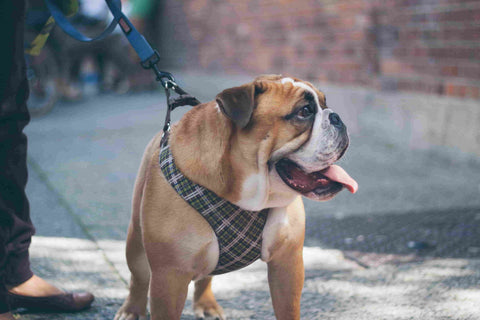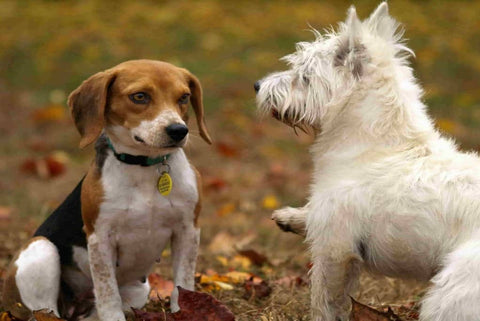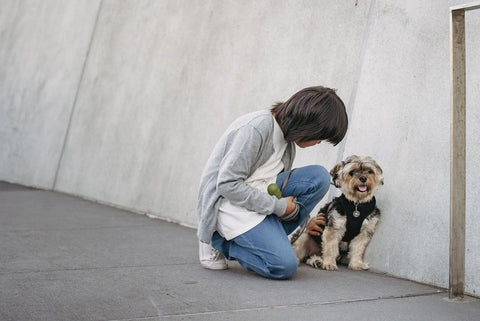How to Choose the Right Harness for a Senior Dog
Your senior dog's vitality and physical abilities are no longer what they were when he was younger. A harness is an excellent accessory for elderly dogs because it provides complete support and is fully adjustable. It is also made of breathable materials, ensuring your pet's safety and comfort. If your senior dog loses stability during outdoor activities, using a harness can help prevent serious injuries.
There are many different types of harnesses on the market, so do your research and select a harness designed specifically for older dogs. “What’s a good harness for senior dogs?” you ask. Read on to know.
Features to Look in a Senior Dog Harness
There are a few key features to look for when selecting the best harness for senior dogs. These will keep your pet safe, secure, and comfortable. When deciding on a good harness for senior dogs, keep the following factors in mind.
- Soft padding. Soft padding is an important feature of any harness that ensures your dog's safety and comfort. It can reduce skin rubbing while still providing a comfortable wearing experience during any activity.
- Breathable & Lightweight Material. Harnesses made of this material are less likely to cause discomfort or heat exhaustion in your dog, which can be a problem for older dogs who aren't as active as they once were. Furthermore, breathable and lightweight material allows your dog to move more freely, which is especially important for elderly dogs who may not be as agile as they once were.
- Comfortable Design. Your dog's harness, like any other piece of equipment, should be comfortable. When purchasing a harness, try it on your dog and adjust the straps. The best harness for senior dogs should be snug but not overly so. It may cause discomfort or even injury if it is too tight.
- Easy on & off features are essential in harnesses for senior dogs. As dog's age, they may have difficulty getting up and down. A harness with easy on & off can help make things a little easier.
- Adjustable Straps in harnesses are also a feature to consider. As our dogs get older, they may develop health issues that make them difficult or uncomfortable to control while walking. Adjustable straps on a dog harness can come in handy here. An adjustable strap will distribute the dog's weight evenly across the harness, reducing pain and discomfort.
- Full Body Support. A full-body harness for senior dogs that provides ample support can help reduce the risk of injuries by keeping the dog's body in a more stable position. This is especially important when walking or hiking with a senior dog, as it can help keep them safe on uneven terrain and prevent them from slipping and falling.
- Easy to Clean. A simple design with few straps and buckles allows for easy washing by hand or in the washing machine. This is significant because older dogs are more prone to skin irritation and other health issues. Difficult-to-clean harnesses can quickly become breeding grounds for bacteria and fungus, resulting in infection and discomfort.
How to Select the Right Harness Size
The size and breed of your senior dog are the first things to consider. Even dogs of the same breed can have varying measurements and sizes, so it's best to accurately measure for a tailor-fit harness for your pet. We've put together an easy-to-follow step-by-step guide on how to measure your dog for a harness. You can certainly get the best harness for your senior small/medium/large dog with this.
When you already have your measurements, compare them to the Pet&Cuddle size chart. If your dog is in between sizes, go with the larger size.
After receiving the harness, try it on, fasten it securely, and push two fingers beneath the straps to see how it fits. If you can't correctly accommodate two digits, it's too small. If the harness easily slips over your dog's head, it's too big or flimsy. If you can easily slip the harness over your dog's head, it's too big or too loose and needs to be adjusted.
Signs That Your Senior Dog Needs a Harness for Support
As our dogs get older, they may require more assistance and support to get around. A harness is one of the best ways to provide this support. Here are some indications that your senior dog requires support from a harness:
- Your dog's legs are getting weak. A harness is essential for senior dogs/dogs because their legs may become soft. This can occur in either the front, back, or both legs. A harness will help to support your dog and make them more comfortable, regardless of where the weakness is.
- Your dog has health mobility issues and needs to reduce pressure on its legs. With so many different harnesses on the market, deciding which one is best for your senior dog can be difficult. A soft harness is the best type of harness for a senior dog. When moving, this type of harness places no pressure on the limbs.
- It’s difficult for your dog cannot jump in/out of a car, which is a sign that your senior dog needs a harness for support. This is because their bones and joints aren't as flexible as they used to be. A harness can help by providing extra stability and support.
- It’s difficult to climb up the stairs is another indication. If your senior dog has trouble climbing the stairs, it may be time to invest in a harness. A harness for your senior dogs/dog can help take the strain off their joints and muscles and make it easier to get up and down the stairs.
- Your dog has stability or balance problems. This can be due to several factors, including joint pain, muscle weakness, and inner ear infections due to aging. If you notice that your senior dog is having difficulty standing up or walking, it’s time to invest in a harness.
- Other reasons or signs that your senior dog needs a harness are:
- As your senior dog's vision starts to deteriorate, he may have trouble seeing obstacles in his path. A harness can help him navigate his environment and keep him safe from harm.
- If your senior dog is losing hearing, a harness can help you communicate with him and keep him safe. For example, if he doesn't hear you coming up to him, he may startle easily and fall over.
Benefits of Using a Harness for Senior Dogs
A harness for our aging furry friend provides a lot of benefits not only for your pet but as well as you, the pet owner. For starters, they provide better support, additional protection to your dog’s body, and extra lifting assistance. Here are some more reasons why you should invest in a quality full-body harness for senior dogs.
Helps to Keep the Balance
Senior dog harnesses may be useful in maintaining balance and avoiding falls. Wearing a harness can also help protect their fragile bones from injury if they trip and fall while participating in outdoor activities.
Easy Lifting Assistance
A harness can provide your senior dog with the simple lifting assistance they require to get around without putting undue strain on their body. This provides comfort while also avoiding back pain or joint strain on the pet chaperone.
Extra Support on Stairs
As your dog gets older, it may experience more aches and pains. One way to help ease their discomfort is using a harness instead of a leash attached to their collar. A harness can provide extra support on stairs or getting in and out of the car. It can also help prevent pulled muscles or other injuries.
Protect Your Dog's Back
When your dog is a puppy, you may not think twice about letting them run and jump around unsupervised. However, as they age, it is critical that they are aware of the potential risks that their aging body may face. One of these dangers is a back injury. By evenly distributing your senior dog's weight, a harness can help protect its back.
Assistance During Recovery
A harness can give them the support they need to stay active while also assisting them in recovering from injuries or surgery. If your senior dog suffers from arthritis, a harness can relieve pressure on their joints and allow them to move around more easily. A harness can also provide support and help your dog avoid re-injury after an injury or surgery.
Help For Dogs With Mobility Problems
Dogs are our devoted companions, and we want to do everything we can to ensure that they live a long and happy life. Unfortunately, as dog's age, they may develop mobility issues. That's where a harness comes in, as it can help relieve strain on your dog's legs and back, allowing them to move around more easily.
Find The Perfect Harness for Your Dog at Pet&Cuddle!
If you're looking for retractable leashes that are both good for your senior dog and good for you, look for a leash made of high-quality materials with a long-lasting design that is both pleasant and safe for your pet.
At Pet&Cuddle, we took careful thought into every aspect of the design of our retractable leashes. Because of its long length and simple lock/release button, we guarantee that you will be able to use this leash for activities such as running, jogging, walking, and other sports. Even in crowded public places, our extendable leashes make loose leash walking and heeling a breeze.
You can choose from a range of retractable dog leashes in various styles, colors, and sizes to fit your needs.
Common Questions About Senior Dog Harnesses
Do you have any more questions about which harness is best for your senior dog? We answer some of the most frequently asked questions regarding getting a harness for old dogs.
Should a senior dog wear a harness all the time?
No, it is not advised to have your senior dog wear a harness all the time. Harnesses should only be worn when necessary, such as for walks, runs, training, or lifting. To prevent fur tangling, skin infections, and injury, you should take it off as soon as the activity is finished.
Can senior dogs back out of harnesses?
Some dogs can wriggle out of their harnesses despite proper leash usage, measurement, or harness adjustment. Especially when the harness is put on incorrectly, it can cause the dog to begin retreating backward and then run away.
Are collars or harnesses better for senior dogs?
In most situations, a harness is preferable to a collar. They provide improved safety, functionality, adaptability, and warmth compared to collars.
A harness is a practical choice for training your dog to walk on a leash without getting harmed. It allows you to avoid entanglement, which can be harmful to your dog and to you.
Further, a dog harness lets you have more control while walking, making you feel more secure in crowded public areas. You'll be less concerned about arm and back discomfort because you won't have to worry about a big dog pulling on your arms and back.
Finally, harnesses are great for safety. They reduce the risk of pain and injuries when compared to collars.
Do vets and dog trainers recommend harnesses for senior dogs?
As recommended by qualified veterinarians and dog trainers, harnesses are the best accessories you can invest on for your elderly furry friend. The appropriate harness can assist you in helping your senior dog if he requires support getting up or going downstairs, entering the car, or any other activity. Pulling up on the leash just a little might help keep the pet stable and aid balance—these are just a few of many reasons you should invest in the best harness for your senior small/medium/large dog.




